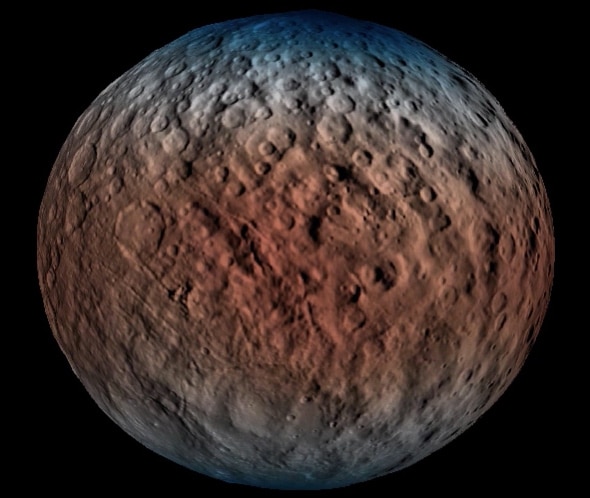Create a free profile to get unlimited access to exclusive videos, sweepstakes, and more!
The Protoplanet Ceres: Water, Water, Everywhere

Ceres is the largest object in the asteroid belt between Mars and Jupiter. It was once thought to be just the largest of the asteroids there, but now planetary scientists are starting to call it a protoplanet: An object that was well on its way to becoming a true planet in the early days of the solar system before it ran out of “food” (smaller asteroids colliding with it and adding to its size).
And while you might be hard pressed to compare it to Earth —it’s far smaller, colder, rockier, airless, and and and— there is one striking similarity it has to our home world: It’s covered in water.
New results from the Dawn spacecraft indicate the presence of water all over Ceres. Now mind you, at an average distance of 400 million kilometers from the Sun, that water is in the form of ice, but still. This is very cool news!
Dawn has been orbiting Ceres since March of 2015, taking pictures and all kinds of measurements of the little world. The first images showed bright spots dotting its surface that were thought at first to be ice, but are now seen to be salty deposits, probably from upwelling briny water from underground. But their locations are scattered, and it was unclear if they were local features or indicative of something global.
Turns out, it’s global! An instrument on Dawn measures neutrons, subatomic particles, coming off the top meter or so of the surface of Ceres. These get emitted when cosmic rays, very fast subatomic particles coming from deep space, slam into the surface of Ceres. Some fly directly into space, but some are slowed down a bit by different materials in the surface. This can be measured and used to figure out what materials are there.
What they found is hydrogen, and lots of it. Some of that hydrogen is probably a component of simple minerals, but the majority of it is almost certainly locked up in water (a molecule of water is one oxygen atom with two hydrogen atoms bonded to it).
This finding is bolstered by the location of the hydrogen: It’s more abundant at higher latitudes and the poles, where it’s colder, though the equator is no slouch either. This video shows the location of the water:
Red is where there’s less, and blue more. But even then, the drier locations still have plenty of water ice; it probably makes up as much as 10 percent of the top meter of the surface of Ceres by weight! The surface composition is probably gravelly rock with ice filling the spaces in between.
Interestingly, the materials on the surface look like they were the outcomes of being processed in liquid water, as if deep inside Ceres the water was warm enough to stay liquid, and minerals there interacted with it, changing chemically. This makes sense; when Ceres first formed, it was warmed by radioactive material in its core. This kept it liquid long enough for heavy material like rock to mostly fall to the core, and lighter material like water to rise nearer the surface. It got mixed in with the rock there, and has lasted for billions of years.
Not only that, by high concentrations of water were found in a handful of perpetually dark craters near Ceres’s north pole. Because of their high latitude, the Sun never shines down into the crater floors, providing “cold traps” where ice can persist. This is also seen on our own Moon and even on Mercury, despite how close it is to the Sun! Watch:
That animation show how it works; as Ceres spins, the Sun never gets high enough above the horizon to warm the crater floor.
So Ceres is loaded with water. We kinda knew that, to be honest, but now we know it’s all over the place. That’s very interesting indeed; future astronauts need water to survive; besides its obvious use for drinking, the oxygen can be broken off to make air, and it can also be processed to make rocket fuel. Ceres may become a way station (or even an industrial complex) for future humans exploring the solar system.
Oh, and one more thing: I’ve written about the 90-km-wide crater Occator on Ceres many times. It has two very bright spots in it, obvious even when Dawn was still weeks away from achieving orbit. These broad salt deposits have been given names by scientists: The big one in the middle of the crater floor is called Cerealia Facula, and the more dispersed one is called Vinalia Facula. “Facula” is Latin for spot, which is obvious enough. Cerealia and Vinalia were festivals in ancient Rome for the harvest and for wine, respectively —Ceres was the goddess of the harvest (and that’s where the word “cereal” comes from).
Is this of scientific interest? Nope. I just thought the names they used are cool. I like it when science mixes with other fields like art, literature, and history. Mythology, too. Knowing these names may not make you more scientifically adept, but it does make you a more interesting person.
I wonder if, someday when humans live on and inside Ceres, they’ll grow grapes there? If so, then mythology and science will have intertwined again, and in a tasty way. I hope that future does come to pass. Cerean wine —assuming they desalinate the water first— would be something I’d love to try.


























